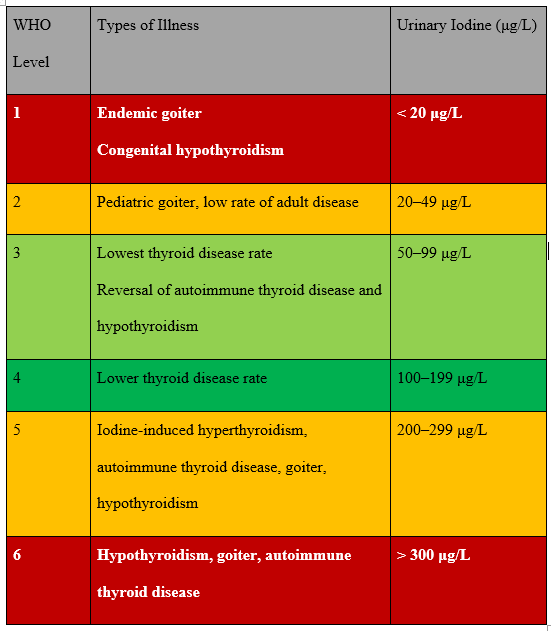Iodine is such a source of confusion. Are we getting too little? Are we getting too much? And what does this mean for our overall health, especially our thyroid health?
ITN faculty member and naturopathic medical doctor, Dr. Alan Christianson, sat down with ITN founder Cynthia Garcia to clear up the confusion and discuss iodine and its effects on thyroid health.
The good news is, the number of countries that were severely deficient in iodine has gone from 112 (in the early 1990s) down to zero as of 2014. But what happened was, we now have 52 nations categorized as at risk for thyroid disease due to iodine excess. And the United States is amongst those 52. It is believed that this excess is one of the main drivers of the increase of thyroid disease in these last few decades.
Thyroid Disease is on the Rise
In the last couple of decades, thyroid cancers and autoimmune thyroid diseases have tripled. And, over the same timeframe, the amount of iodine in processed foods has tripled. It’s a real tight correlation.
But iodine isn’t just hiding in our foods, it’s also in our cosmetic products. Some conditioners contain iodine which may show up as the ingredient PVP, or kelp extract or sea vegetable extract if it’s a natural product. With these products, some people may be exposing themselves to eight times the 200mcg safe upper limit of iodine. This is with conditioner alone and doesn’t even factor in food, other topical ingredients, or salts.
Visible Iodine Sources
- Multivitamins
- Iodine Supplements
- Thyroid Support
- Iodized Salt
- Sea Vegetables
- Seafood
Invisible Iodine sources
- Sanitizers (Iodine was taken out of hand sanitizers just a couple years ago because of the high rates of thyroid disease showing up amongst health care workers using them.)
- Cosmetics
- Non-Iodized Salts
- Commercially Baked Goods
- Dairy
It’s important to recognize that we don’t just absorb iodine orally, we can also absorb it through our skin and respiratory system.
What We Know About Iodine
The tolerance of iodine is narrower than we thought. The World Health Organization (WHO) has stated that those who do not have thyroid disease, may safely be exposed to iodine as high as 1100 mcg/day. For those who have or are prone to thyroid disease, data shows their safe upper limit appears to be closer to 200 mcg. While there is a safe upper limit, there is also a safe lower limit of 50 mcg to consider. It’s important to note that the ideal range for pregnant women is different, and the latest guidelines suggest the ideal range is a level of 150 – 250 mcg/L.
How Does Iodine Slow the Thyroid Down?
The thyroid uses iodine to make thyroid hormones. What happens is iodine attaches to a protein called thyroglobulin and you end up with T4 and T3. But what happens when there is a lot of iodine present in the body? A protective mechanism called the Wolff-Chaikhoff effect is engaged.
What this means is that your thyroid responds to an excess of iodine by producing less thyroid hormone and ultimately slows or shuts off the thyroid. Think about this like a fuse box for a home. If there’s too much current in the wiring, you blow a fuse, so you don’t burn down the house. So, when too much iodine comes into the thyroid, the thyroid shuts down so it doesn’t damage your heart.
But There’s a Large Difference for Iodine Tolerance
Many people can get extra iodine and just slough it off like water off a duck’s back, no big deal. But they’re not the ones who are ever going to get thyroid disease. So those prone to thyroid disease are the ones who can’t tolerate that occasional excess. Here’s the evolutionary story behind that.
We think that humans had a couple of different iodine environments in which they evolved, and therefore genetic variation that’s persisted. One group was largely coastal, and their diet contained large amounts of sea foods: sea fish, sea vegetables, shellfish, etc.
And you see, our bodies have a way of pulling in iodine or getting rid of iodine. So, those who were coastal got really good at getting rid of iodine. They had good excretion mechanisms because they took in a lot of iodine. Now, this mechanism is on a seesaw, meaning, when you can get rid of iodine well, you can’t pull it in well. So this pump that’s pulling in iodine weakened, but because this group was exposed to so much iodine they didn’t need a strong pump.
Now the other big group of humans was more inland and in areas that had very iodine poor soil. Nowadays we try to encourage locally sourced food, but back then if that’s all you had, and your soil was devoid of some nutrients, then you were too. However, those people had really strong pumps and really weak eliminators. They couldn’t get rid of iodine, but they could store it, and they would use every speck they got. They needed strong pumps and weak eliminators because they always had low amounts of iodine. So, that’s the genetic trait that still shows up amongst many people. What we’re seeing now is that when they’re in an environment of iodine excess, they’re used to storing iodine so they can’t get rid of it. That extra amount turns out to be the largest driver of thyroid disease.
If You Deliberately Clear Out Excess Iodine, Thyroid Disease Can Often Go Away
One researcher quoted that iodine is not the only cause of thyroid disease, but it’s more relevant than all the other causes combined.
So, this is the simple story… We now know that extra iodine not only slows the thyroid but also drives the autoimmune response. And the exciting part of the story is that this whole thing is reversible. We once thought that if your thyroid started to slow down, it was on an irreversible track off the side of the mountain. But we now know that for many people, that’s not the case. For the majority of people, it can be reversed just by clearing out excess iodine.
Research has shown that when there are high amounts of iodine present, it creates free radical damage, pulls in immune cells, and destroys the cells of the thyroid. But if you deliberately clear out the access, the disease can often go away.
As seen in clinical evidence, regulating iodine intake and monitoring symptoms has shown to be very effective. One study that looked at people that had hypothyroidism for no clear reason found that in eight weeks 21 out of 23 people saw a full recovery of thyroid function by simply regulating iodine. A follow-up study with people who have Hashimoto’s found that within 3 months the average TSH score went from 14 to 3.
A Growing Problem
In the last decade, thyroid cancers and autoimmune thyroid diseases have tripled.
Thyroid disease is most prominent in adult women, and each decade in life, it gets more common. By the time women reach their later years, a quarter have severe versions of thyroid disease.
And the sad thing is that as common as it is, most are not even diagnosed, and of those who are diagnosed, most are not effectively treated. There was a big survey of 12,000 people done in 2018 by a thyroid advocacy group. What they saw was that of these people, less than 7% considered their thyroid treatment effective, and over 30% had seen 10 or more doctors.
Cutting-Edge Research and Clear Results
Dr. Alan Christianson has set out to reverse thyroid disease and provide people real and effective solutions.
In his new book, The Thyroid Reset Diet, he identifies 600 different foods and their iodine profiles (you won’t find this information on nutrient databases or apps).
Instead of following a restrictive diet for thyroid health, The Thyroid Reset Diet does not require eliminating any food category. Instead, Dr. Christianson recommends food swaps like brown rice instead of processed bread to regulate iodine intake. He shares the latest on supplements and other thyroid health strategies, along with more than sixty-five recipes, weekly meal plans, and maintenance info. His cutting-edge research and clear results, coupled with an easy-to-follow diet plan, will help anyone struggling with thyroid disease.
Backed by new research showing that proper dietary iodine intake can start to reverse thyroid disease in as little as four weeks, his diet plan contains the optimal amount of iron and dietary iodine to control thyroid hormones, effectively resetting the thyroid.
Want access to more cutting-edge research like this? Consider enrolling in our Certified Transformational Nutrition Coach course!


+ show Comments
- Hide Comments
Free Resources
Take A Look at the latest from ITN:
Courses
add a comment